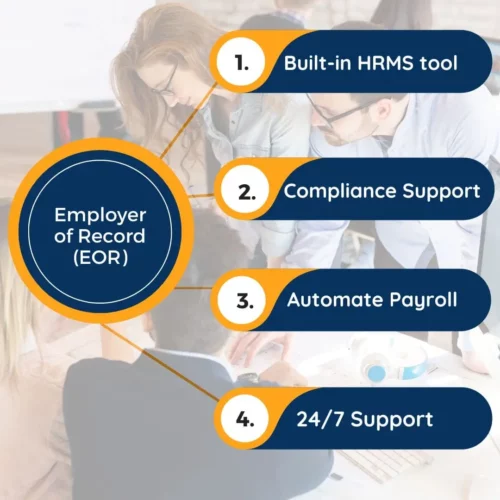Employer of Record USA
Employer of Record Services United States Of America
Globally #1 Ranked EOR & Payroll Management for USA is right here.
Leverage the best talent in the USA to suit your growing business requirements. Choose Asanify’s Global EOR Services, especially for employment solutions in USA, to get started within 24 hours and be 100% compliant on payroll and all statutory compliances.





Schedule a Consultation
Hire Full-time Employees in USA
Asanify is your 1-stop EOR Solution: HRMS, Payroll, Compliances, Recruitment and Tax-saving
Asanify’s USA Employer of Record (EOR) services bring extensive expertise in managing payroll and statutory compliances for your teams in USA. You can rely on our knowledgeable support to onboard and manage your USA team. Asanify’s Employer of Record (EOR) solution provides the expertise and support you need to hire talent in USA and expand your business confidently. Our EOR service handles hiring, onboarding, payroll, compliance, and risk management, allowing you to focus on growing your business and achieving your goals.
If you’re considering hiring specialized skill sets in USA — look no further.










OUR EXPERTISE
Hiring and Managing your USA Workforce
Deep Local Expertise
Asanify's deep knowledge and experience in managing recruitment, payroll & compliances in the 30+ States in India is unparalleled.
Salary Structuring
Asanify offers the additional service to your employees by helping them structure their salaries in more tax-friendly manner, so they can save more.
No Local Entity Required
You do not need any local presence, as Asanify takes care of all employment related documentation and payroll related compliances.
24 * 7 Customer Support
Our round the clock customer care ensures that you and your employees always have the personal support for any query that you may have.
Check out the Overall Employment Cost for the desired Gross EUR Salary for your Team in USA
We are proud partners for some of the finest global companies















YOUR SINGLE DESTINATION FOR EOR IN USA
Personalised Employer of Record services in USA
With Asanify, whether it is recruiting talent or managing them, our dedicated Account Manager is the single point of contact for all your queries. Once the employee is finalized, it takes less than 24 hours for you to get started.
YOUR USA TEAM MANAGEMENT SIMPLIFIED
EOR Compliances in USA
With Asanify, you get complete coverage of local compliances – no matter where your employee may be based in India.
- Provident Fund: Employees can choose the contribution amount
- ESIC (State Insurance): for all applicable States in India
- Health Insurance: Coverage worth INR 500K for Employee + Family
- Labour Welfare Fund contributions for all States
- State-specific Professional Tax
- Income Tax Deduction and Filing as per the Government Laws

OUR USA CAPABILTIES
How Asanify EOR USA becomes your 1-Stop Shop
Salary benchmarking across roles when you are looking to hire. This enables you to be competitive while attracting new talent.
Thorough onboarding process to ensure complete documentation and that your team gets covered under all local compliances
Recruitment support across the country to identify candidates with the right skillset to match your specific requirements
Fully automated HR Management System to ensure that you manage your teams effectively and drive productivity
People Analytics and AI-driven insights to help you track the right KPIs when it comes to managing your teams
Round the clock customer support for any assistance that may be required by you or your India team
TESTIMONIALS
What our happy customers of EOR Services have to say

Asanify's, should be the number 1 choice for companies looking to pay their overseas employees and contractors. I have a team of 40 people in India and not for a single month have i experienced any delays in the payment process.

In my business, things happen fast, and requirement for new employees is sudden. In such a situation a trusted partner like Asanify comes in handy as I know I can quickly ramp with onboarding and employee formalities diligently taken care of.

As a global company, we go through M&As in countries where we do not have presence. In India, we quickly onboarded ~30 employees as part of a takeover. With Asanify's turnaround time the overall change was managed brilliantly.

Asanify’s expertise when it comes to Local Compliances is something I have benefitted extensively from. Whether its Employee-Contractor classification, or the local laws for employee benefits and working hours - I trust the guidance provided.

Apart from using EOR services, I find a lot of value in the fully automated Asanify HRMS. For me, it makes it absolutely comfortable that I can access all my HR inforation anytime, anywhere and on any platform - Slack, Whatsapp etc.

My employees are in India, while I am based in Dubai and the co. in the US. Managing time zones is a huge challenge for us. Working with global partners like Asanify ensures that all my payments, and query resolutions are done in time.

It is paramount that my employees are well taken care of. Asanify goes above and beyond In terms of employee benefits, salary structuring to make it more tax friendly and constant guidance. For over a year with Asanify’s EOR, I have had no reason to feel disappointed.
Read some of our useful Blogs on EOR Services
In today’s fast-paced digital landscape, businesses across the globe are increasingly turning to dedicated developers to build and scale their

Magento is a powerful, open-source eCommerce platform widely used by businesses around the world. Known for its flexibility, scalability, and
CodeIgniter is a lightweight and high-performance PHP framework known for its speed, simplicity, and minimal configuration. It’s ideal for building
What is an Employer of Record (EOR) in the USA?
An EOR in the USA, like Asanify, legally employs workers on your behalf, handling employment contracts, payroll, benefits, taxes, and compliance across different states—allowing you to hire without establishing your own US entity.
Why should I choose Asanify’s EOR services for hiring in the USA?
The USA has complex, state-specific labor laws and tax obligations. Asanify ensures full federal, state, and local compliance, manages employee benefits, and enables fast, legally secure hiring without administrative burden.
Does Asanify handle tax withholding and compliance across all US states?
Yes. Asanify manages federal taxes (IRS), state income taxes, FICA contributions (Social Security and Medicare), unemployment insurance, and ensures full multi-state payroll compliance.
How does payroll work through Asanify’s EOR in the USA?
Asanify processes bi-weekly or monthly payroll cycles (depending on your preference), handles mandatory deductions, generates W-2s or 1099s (if applicable), and ensures accurate, timely salary payments.
Can Asanify manage employee benefits like health insurance and 401(k) plans?
Yes. Asanify offers access to comprehensive benefits packages in the USA, including health insurance, dental/vision plans, 401(k) retirement savings, and paid leave management, tailored to your needs.
Can Asanify help hire remote employees across different US states?
Absolutely. Whether you’re hiring in California, Texas, New York, Florida, or any other state, Asanify ensures compliant onboarding, tax setup, and benefits administration.
How fast can I onboard employees through Asanify in the USA?
Onboarding timelines are very fast—employees can often start working within 3–5 business days after contract signing and background checks (if required).
- Compliance with local laws
- Employee agreements in India
- Gratuity
- Tax compliance
- Benefits and leave compensation
Does Asanify support both full-time employees and independent contractors in the USA?
Yes. Asanify can employ full-time W-2 employees or help you compliantly engage 1099 independent contractors, while ensuring worker classification compliance to avoid IRS penalties.
- Reduced liability
- Contractual obligations
- Intellectual property protection
Can I transition EOR employees to my own US entity later?
Yes. If you decide to establish your own US legal entity, Asanify can smoothly transfer employees to your company’s payroll and help manage the exit process from EOR.
How secure is employee data under Asanify’s EOR service in the USA?
Very secure. Asanify complies with US data privacy laws like the California Consumer Privacy Act (CCPA) and GDPR, ensuring that employee records and sensitive information are fully protected.
- Hidden costs and fees
- Losing control over your HR processes and policies for employees that are hired through an EOR
- Goals and standards set are different.